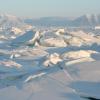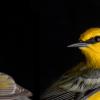Climate & Environment
 CU Boulder is part of a new $100 million interdisciplinary partnership to address critical water security issues in the United States over the next five years, the U.S. Department of Energy announced Monday.
CU Boulder is part of a new $100 million interdisciplinary partnership to address critical water security issues in the United States over the next five years, the U.S. Department of Energy announced Monday. Loaded with research equipment and CU Boulder scientists, the RV Polarstern icebreaker is steaming towards the central Arctic, searching for the perfect parking spot next to an ice floe.
Loaded with research equipment and CU Boulder scientists, the RV Polarstern icebreaker is steaming towards the central Arctic, searching for the perfect parking spot next to an ice floe. The National Snow and Ice Data Center announced Monday that Arctic sea ice reached its likely minimum extent on Sept. 18, 2019.
The National Snow and Ice Data Center announced Monday that Arctic sea ice reached its likely minimum extent on Sept. 18, 2019. Researchers reflect on the lessons learned from a landmark multinational agreement protecting Antarctica's Ross Sea.
Researchers reflect on the lessons learned from a landmark multinational agreement protecting Antarctica's Ross Sea. Hundreds of researchers from 19 countries are launching a yearlong journey to study Arctic climate.
Hundreds of researchers from 19 countries are launching a yearlong journey to study Arctic climate. Thick, impenetrable ice slabs are expanding rapidly on the interior of Greenland's ice sheet, sending meltwater spilling into the ocean.
Thick, impenetrable ice slabs are expanding rapidly on the interior of Greenland's ice sheet, sending meltwater spilling into the ocean. Researchers at the Institute of Arctic and Alpine Research (INSTAAR) have been awarded $3 million to study the changing climate and rivers of Alaska and western Canada.
Researchers at the Institute of Arctic and Alpine Research (INSTAAR) have been awarded $3 million to study the changing climate and rivers of Alaska and western Canada. Photographers and others with a keen eye have noticed that sunrises and sunsets have become a lot more purple in the U.S. New measurements from a high-altitude balloon could explain why.
Photographers and others with a keen eye have noticed that sunrises and sunsets have become a lot more purple in the U.S. New measurements from a high-altitude balloon could explain why. A gene newly associated with the migratory patterns of golden-winged and blue-winged warblers could lend insight into the longstanding question of how birds migrate across such long distances.
A gene newly associated with the migratory patterns of golden-winged and blue-winged warblers could lend insight into the longstanding question of how birds migrate across such long distances. Dozens of CU Boulder researchers will take part in the MOSAIC expedition, which will send an icebreaker ship into the winter pack ice to drift for an entire year.
Dozens of CU Boulder researchers will take part in the MOSAIC expedition, which will send an icebreaker ship into the winter pack ice to drift for an entire year.


